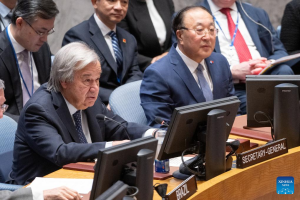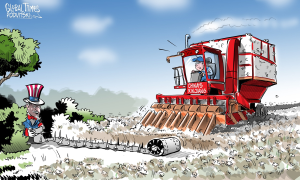Recently, at the invitation of U.S. President Joe Biden, Chinese President Xi Jinping flew across the Pacific Ocean on a trip to San Francisco. At the century-old Filoli Estate, Xi held a meeting with Biden to find the right way for China and the United States to get along with each other.

At this critical juncture of history, the San Francisco meeting between the Chinese and U.S. presidents achieved significant outcomes, making a key step to steer China-U.S. relations toward a healthy, stable and sustainable direction.
Xi pointed out that China and the United States should jointly develop a right perception, manage disagreements effectively, advance mutually beneficial cooperation, shoulder responsibilities as major countries, and promote people-to-people exchanges. This has built together five pillars for China-U.S. relations and established the “San Francisco vision” oriented toward the future.
To jointly develop a right perception comes first in the five pillars, which mirrors Xi’s profound thinking on the real challenges and future direction of China-U.S. relations.
“I have always had one question on my mind: How to steer the giant ship of China-U.S. relations clear of hidden rocks and shoals, navigate it through storms and waves without getting disoriented, losing speed or even having a collision?” Xi said at a welcome dinner by friendly organizations in the United States.
“In this respect, the number one question for us is: are we adversaries, or partners? This is the fundamental and overarching issue,” said Xi.
Xi’s important remarks made at the welcoming dinner were thought-provoking. China and the United States are two major countries with extensive common interests and bear important responsibilities for world and regional peace, stability, and prosperity. For China and the United States, turning their back on each other is not an option. It is unrealistic for one side to remodel the other, and conflict and confrontation has unbearable consequences for both sides.
In recent years, China-U.S. relations have encountered challenges and difficulties. The root cause is U.S. misperception toward China and the China-U.S. ties.
Some people in the United States hold onto the Cold War mentality and zero-sum game mindset, seeing China as a primary competitor and the most consequential geopolitical challenge, which severely distorts the perception of China. It will only lead to misinformed policymaking, misguided actions, and unwanted results.
To find the right way to get along with each other, China and the United States need to jointly develop a right perception. Only by doing so can the foundation for mutual respect, peaceful coexistence, and win-win cooperation be laid.
Jointly developing a right perception means the two countries must accurately understand each other’s strategic intentions.
Xi pointed out that China’s development is driven by its inherent logic and dynamics. China is promoting the great rejuvenation of the Chinese nation on all fronts through Chinese modernization. It will not take the old path of colonization and plundering, or the wrong path of seeking hegemony with growing strength. It does not export its ideology. It has no plan to surpass or unseat the United States. Likewise, the United States should not scheme to suppress and contain China.
China is consistently committed to having a stable, healthy and sustainable relationship with the United States. China never bets against the United States, and never interferes in its internal affairs. China has no intention to challenge the United States or to unseat it. Instead, China will be glad to see a confident, open, ever-growing and prosperous United States. Likewise, the United States should not bet against China, or interfere in China’s internal affairs. It should instead welcome a peaceful, stable and prosperous China.
In recent years, some people in the United States, out of their strategic anxieties, have seriously misjudged and deliberately distorted China’s strategic intentions. They stubbornly view China, which is committed to peaceful development, as a threat and thus play a zero-sum game against it. They are going further down the wrong path.
To prevent the giant ship of China-U.S. relations from getting disoriented, losing speed or having a collision, such misperception toward China must be eliminated first.
Jointly developing a right perception means the two countries must practically respect each other’s legitimate rights and interests. China hopes to see win-win cooperation with the United States. At the same time, China has interests that must be safeguarded, principles that must be upheld, and red lines that must not be crossed.
Over the past decades, the relationship between China and the United States has experienced ups and downs, and the U.S. side should have a clear understanding of this.
Taiwan question remains the most important and most sensitive issue in China-U.S. relations. The U.S. side should take real actions to honor its commitment of not supporting “Taiwan independence,” stop arming Taiwan, and support China’s peaceful reunification. China will realize reunification, and this is unstoppable.
U.S. actions against China regarding export control, investment screening and unilateral sanctions seriously hurt China’s legitimate interests, and go against the U.S. promise of not seeking to contain or suppress China’s development.
Development of China is innovation-driven. Stifling China’s technological progress is nothing but a move to contain China’s high-quality development and deprive the Chinese people of their right to development. It is important that the U.S. side take China’s concerns seriously and adopt tangible steps to lift its unilateral sanctions so as to provide an equal, fair and nondiscriminatory environment for Chinese businesses.
The world is developing, and the times are changing. China and the United States cannot repeat the outdated history of major-country confrontation. Instead, the two countries should be partners that respect each other, coexist in peace, and work together for mutual benefit. This is the right choice for the future.
In recent years, China-U.S. relations have been at a low ebb, leading to an increase in discussions about the “Thucydides trap” in the international community. The crux of the “Thucydides trap” lies in a cognitive error rather than objective conflicts of interest.
Xi once pointed out that there is no such thing as the so-called Thucydides trap in the world. But should major countries time and again make the mistakes of strategic miscalculation, they might create such traps for themselves, he explained.
This time in San Francisco, he once again stressed that the world is big enough to accommodate both countries, and China is ready to be a partner and friend of the United States.
What he said demonstrated profound wisdom in grasping the development of China-U.S. relations while following the logic of historical progress and the trend of the times, and showcased a broad-mindedness in planning the development of China-U.S. relations at the level of the future of humanity and Planet Earth.
China and the United States, the largest developing country and the largest developed country, must handle their relations well.
Both sides should take the San Francisco meeting as a new starting point to truly implement the important consensus reached by the two heads of state, enhance mutual understanding through communication and dialogue, eliminate biases and misjudgments by developing a right perception, and jointly promote the continuous improvement and development of China-U.S. relations.

